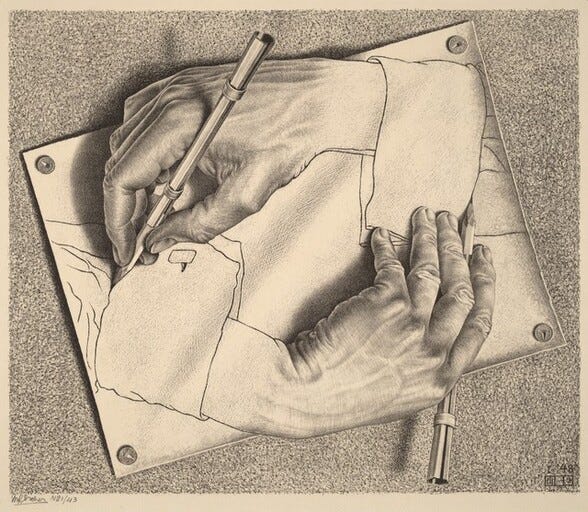Robert’s Ruminations: The New Gilded Age
It is perhaps surprising to notice how similar our modern era is to the Gilded Age. Read on . . .
I will admit that I have my head buried in a history book a good bit of the time, but I do come up for a look around now and again. And one of the things I cannot fail to notice when I do is just how similar in many ways our modern era is to the Gilded Age (roughly 1875-1905, give or take).
Of course there are numerous differences, too (antibiotics, the Internet, etc.), but those will have to wait for a future post. Today I’d like to share with you a few of the similarities between the Gilded Age and our times, which I often call the ‘New Gilded Age’.
Image Credit: M.C. Escher, Drawing Hands, 1948, National Gallery of Art
Corporations were the talk of the nation then, and as you probably know, then-president Theodore Roosevelt earned a fearsome reputation for being a ‘trust buster’. (Trusts were informal collaborations between a small number of large companies, which then could collude to fix prices or at least leave consumers with few alternatives.) If we take the “Meat Trust” as an example, circa 1902 there were only five companies that controlled more than 80% of the nation’s meat supply: Swift, Armour, Morris, Cudahy, and Wilson. The effect of this concentration of production into a very few hands meant that companies could pay cattle ranchers very little for live animals, but then charge consumers whatever they wanted for the resulting meat.
Now guess how many companies today control more than 80% of the nation’s meat supply? Four: JBS, Cargill, Tyson Food, and National Beef.
Think of someone who, like you, is interesting and smart. Surely, they’d appreciate a gift subscription to All That Glitters!
Let’s now turn to the people everyone has always loved to bitch about: The Rich. In 1900, the top 0.5% of Americans (by net worth) held about 40% of the total wealth of the nation. Today, the top 0.5% holds . . . about 40%. This statistic dipped as low as about 20% in the early 1980s, but has been steadily on the rise ever since. Today, the three richest Americans have about as much money as the lower half (about 165 million people) does in total.
And while Gilded Age zillionaires built lavish Newport mansions and booked first-class passage on fancy steamships, today’s equivalents send their friends and family into space for a lark. (By the way, I say this without a trace of envy: If I were offered a free ticket to blast myself into space, I would gratefully decline. I don’t even like tall buildings.)
There is much talk today about immigration, and there was in the Gilded Age too. In fact, in 1900, the United States touched its limit of (legal) immigrants: about 10% of the country’s 75 million people were of foreign birth, or about 7 ½ million people. That record held until 2023: Today the foreign-born account for 13.6% of the total population of about 330 million, or about 45 million people born elsewhere. (These are US Government figures; make of them what you will.)
In 1902, the average unskilled laborer made about $500-600 per year—which represents about $25,000 to $30,000 in modern money, correcting for inflation and dollar devaluation. Today, if we look at New York State, one of the most open-handed about such things, the minimum wage is $13.20 per hour. If an unskilled laborer can bag 40 hours a week, 50 weeks a year, that makes . . . $26,400 per year, arguably on the low end of the Gilded Age wage spectrum for this type of person.
The final thing for today is casual sex. This activity has always been popular, though circa 1900 it was scarce as hen’s teeth unless you visited a prostitute. While prostitution was illegal at the time, that didn’t stop anyone. In fact, most municipalities turned a blind eye to their ‘vice district’ or ‘red light district’—what happened in Vegas stayed in Vegas, even then. New York City had 1 prostitute per 40 men; New Haven had 1 prostitute per 76 men (source: The History of Prostitution, 1897, William W. Sanger, M.D.)
Nowadays, while we still have prostitutes (most sources estimate between 1-2 million of them), the at-your-fingertips alternatives of Tinder, Grindr, OnlyFans, and countless pornographic websites offer the recreational-sex equivalent of a quick stop at the brothel, without that pesky thing called shame. The porn industry rakes in at least $14 billion a year in the US alone, which would place the business of on-demand gratification at about #300 on the Fortune 500 list of largest corporations.
I’ll tackle some of the big differences between now and the Gilded Age in a forthcoming post.







